Text and Photos by Henrylito D. Tacio
“We will be investing in the people, even as we invest in the environment.” These were the words of then-President Benigno S. Aquino III in one of his State of the Nation Addresses.
The words were not taken lightly by those people who were victims of natural disasters like floods, landslides, earthquakes, and volcanic eruptions.
For instance, the “flooding problems,” Aquino said, “are caused by the incessant and illegal cutting down of trees.”
More often than not, politicians use one possible solution to the problem – that of tree-planting – as a photo opportunity. “They plant trees, but they do not ensure that the trees will remain standing after they leave,” Aquino pointed out.
Where have all our forests gone?
American President Theodore Roosevelt said, “People without children would face a hopeless future; a country without trees is almost as helpless.”
In a span of 15 years – from 1990 to 2005 – the Philippines lost roughly a third of its forest cover, said Senator Juan Miguel F. Zubiri. The deforestation rate then was placed at 2% per year. Today, the country has approximately four million hectares of forest resources.
A pair of the Philippine eagle needs at least 7,000 to 13,000 hectares of forest as nesting territory, according to the UN Food and Agriculture Organization.
“Deforestation is terrible,” deplored Dennis Salvador, executive director of the Philippine Eagle Foundation. “The Philippine eagle has become a critically endangered species because the loss of the forest has made it lose its natural habitat.”

Endangered marine turtle 
Denuded mountains
“More than 400 plant and animal species in the Philippines are currently threatened with extinction, including the Philippine eagle and the tamaraw,” the Washington, D.C.-based Population Reference Bureau (PRB) reported.
Deforestation also causes soil erosion, triggering landslides. But erosion is more than just landslides. As a consequence, food production is being threatened by it.
“The loss of topsoil affects the ability to grow food in two ways,” wrote Lester R. Brown and Edward C. Wolf in their book, Soil Erosion: Quiet Crisis in the World Economy. “It reduces the inherent productivity of land, both through the loss of nutrients and degradation of the physical structure. It also increases the costs of food production.”
Deforestation has also destroyed watersheds, which constitute about 75% of the country’s total land area of 30 million hectares. “We cannot talk of providing sustainable water to the people unless we protect the sources of the commodity – the watersheds,” said Elisea Gozun, the former environment secretary.
A report from the Department of Environment and Natural Resources (DENR) said that 90% of the 99 watershed areas in the country are “hydrologically critical” due to their degraded physical condition.
Massive destruction of the once-productive forested watersheds by illegal loggers and uncontrolled land use from mining, overgrazing, agricultural expansion, and industrial utilization have contributed to water depletion.
Compounding the water problem, particularly in the cities, is the surging population. “The rapid urbanization of the Philippines, with more than 2 million (people) added to the urban population annually, is having a major impact on water resources,” said an Asian Development Bank report.
Deforestation doesn’t happen only in the mountainous areas – as most people think – but also in the lowlands. Talk about mangrove forests. The country lost almost 90% of its mangroves, the vast majority since 1970.

Endangered coral reefs 
Watershed
Mangrove denudation has triggered low catch of fish, the secondary staple food of Filipinos – after rice. “An estimated 670 kilograms in fish catch is lost for every hectare of mangrove forest that is clear-cut,” PRB observed.
Equally important as mangroves are coral reefs, considered the “tropical rainforests of the seas.” The Philippines is a haven of corals as its waters are home to approximately 400 of 500 known species.
One square kilometer of healthy coral reef can generate about US$50,000 annually from fishing and tourism. “Philippine coral reefs contribute at least US$1.4 billion annually to the economy,” according to the report from the German Technical Cooperation agency.
The United Nations Environment Program reported that 97% of reefs in the Philippines are under threat from destructive fishing techniques, including cyanide poisoning, dynamite fishing, over-fishing, or from deforestation and urbanization that result in harmful sediment spilling into the sea.
“Overall, destruction of our natural resources is continuing, despite efforts of some of our concerned citizens to protect and manage them,” deplored Dr. Angel C. Alcala, former environment secretary and a recipient of the Ramon Magsaysay Award for public service.
“At the same time,” Alcala added, “the population of the country is increasing. It is obvious that this is a problem that cannot be ignored.”
The warnings are written on the wall. Filipinos must do something now to save what remains of the country’s natural resources and the environment that sustains life. The words of the late Aquino are still timely:
“I am telling you now: We can dream about them, we are capable of achieving them, and we will achieve them. Isn’t it great to be a Filipino living in these times?”
Yes, our natural resources are worth saving for our future generation!

